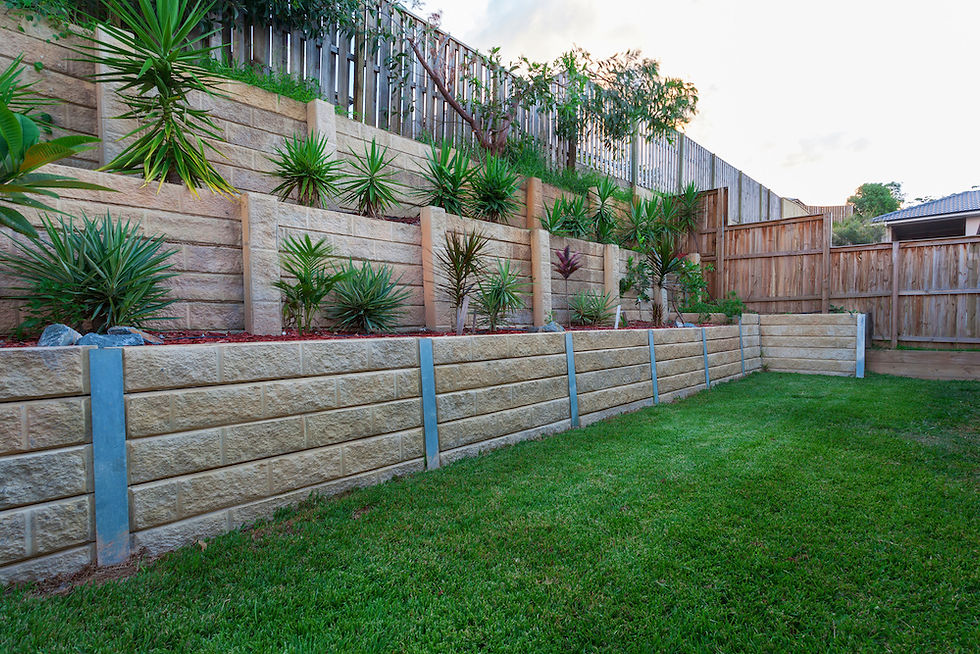Unraveling The Intricate Role Of Retaining Walls In Landscape Design
- louisjack110
- Jul 22, 2025
- 3 min read
Is your outdoor space as functional as it could be? Do you find your property landscape stunning but still feel there is something missing? Do you like the multi-dimensional aura that retaining walls bring to a landscape? If you're nodding your head in agreement, then you're going to love where this conversation is headed. Today, we delve into a significant, but often overlooked, component of exterior design: the retaining wall.
A retaining wall, as simple and discrete as it may appear, plays an enormous role in landscaping. Its purpose extends far beyond aesthetics. This blog post will plumb the depths of retaining walls, revealing their purpose, benefits, and essential role in shaping your garden design. It's time to unravel the intricate role of retaining walls in landscape design!

The Stabilizing Function Of Retaining Walls
Why do landscapers often incorporate retaining walls into their designs? The primary reason is stability. Retaining walls hold back soil from unexpected movement, thus preventing soil erosion. This functionality is especially critical in hilly or sloping areas where soil stability is a major concern.
Having a sturdy retaining wall not only ensures the stability of your garden but also helps to maintain the integrity of your property. Thanks to their solid configuration, these walls also play a vital role in controlling the flow of rainwater, preventing flooding and other forms of water damage.
Aesthetics Matters: Models And Materials
Beyond the practical aspects, retaining walls bring an exceptional aesthetic value to your landscape. These walls come in various shapes, sizes, and materials, including stone, concrete, timber, and brick. Each of these materials boasts distinct qualities and visual appeal, enabling homeowners to customize the wall's look to their liking.
Aligning the choice of materials with the overall theme of your house design can create a coherent and visually appealing landscape. Whether you’re shooting for a rustic ambiance or a more contemporary setting, there's always a retaining wall that complements your theme.
Space Optimization: Terracing & Planting
Ever thought of supplementing your landscape with a terrace or an extra planting space? Terracing is a popular option provided by retaining walls that can add another dimension to your outdoor environment. It allows for better usage of space, particularly in sloping areas.
Steep slopes may have constraints when it comes to planting due to the possibility of soil erosion. Retaining walls step in to manage these slopes and offer increased usable planting spaces. So, not only do you get an exquisite view, but you also gain extra room for your beloved plants.
The Pros And Cons Of Retaining Walls
Like any other component of the landscape, retaining walls possess both advantages and disadvantages you should consider. On the plus side, retaining walls offer stable soil conditions, improved water control, and aesthetically pleasing landscape profiles. They can transform an ordinary looking backyard into an elegant outdoor space.
However, they have their downsides. Constructing a retaining wall can be quite an investment, both financially and in terms of time. They require regular maintenance and can be subject to damage over time due to weather conditions.
Choosing The Right Retaining Wall
Choosing the ideal retaining wall for your landscape isn’t merely about selecting materials and designs. Factors such as the soil type, wall height, load-carrying capacity, and drainage conditions significantly impact the kind of retaining wall that would be best suited for your landscape.
Involving Experts For A Successful Retaining Wall Project
Designing and building a retaining wall is an intricate task. Although it’s possible to create a DIY retaining wall, professional assistance can make your project run smoother and often yield better results. An expert can assess factors like land slope, soil type, and local climate to deliver a functional and aesthetically pleasing retaining wall that stands the test of time.
Conclusion:
Reflecting on the details above, it's clear that retaining walls offer more than just a pretty façade. They play a pivotal role in enhancing a landscape’s functionality and overall appeal. They transform and optimize spaces, providing solutions to landscaping problems you may never have thought existed.
Matching a retaining wall to meet your specific needs requires thoughtful consideration of design elements, materials, costs, and the skills of the professionals involved. Remember, the integrity of your landscape design may depend on the retaining wall—so choose wisely and construct earnestly.
.png)



Comments